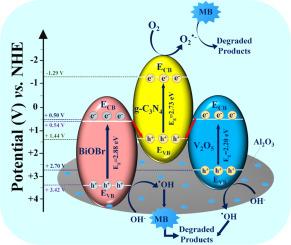Manipulating the charge transfer pathway in a dual Z-scheme BiOBr/g-C3N4/V2O5-Al2O3 heterojunction toward efficient degradation of textile dyes
IF 6.3
3区 工程技术
Q1 ENGINEERING, CHEMICAL
Journal of the Taiwan Institute of Chemical Engineers
Pub Date : 2025-09-06
DOI:10.1016/j.jtice.2025.106373
引用次数: 0
Abstract
Background
One of the main environmental concerns has recently been the contamination of water sources by organic dyes. Organic dyes are an example of pollutants that can seriously contaminate water and endanger the lives of living things. The present article explores the photocatalytic and synergistic response of BiOBr, g-C3N4, and V2O5 photocatalysts via developing a dual Z-scheme system. Here, we have designed a novel alumina (Al2O3) supported dual Z-scheme BiOBr/g-C3N4/V2O5 heterojunction driven by visible light to remove MB dye effectively.
Methods
All photocatalysts were synthesized using an easy-to-use and economical approach. This work employed thermal polycondensation and co-precipitation methods for g-C3N4 and BiOBr fabrication, respectively, while the calcination method was opted for the Al2O3-supported V2O5 photocatalyst. The binary and ternary heterojunctions of Al2O3 supported g-C3N4/V2O5 and BiOBr/g-C3N4/V2O5 were formed using physical mixing and in-situ methods.
Significant Findings
The dual Z-scheme charge transferal route amongst BiOBr, g-C3N4, and V2O5 enhanced MB photodegradation performance by extending light absorption, decreasing the recombination rate, and increasing charge separation efficiency, which was validated via optical, PL, and EIS studies. Also, Al2O3 is used in the ternary heterojunction as a supported material for the adsorption of the dye molecules as well as to boost the charge separation and transportation rate. BET analysis confirmed enhancement in the surface area of BiOBr/g-C3N4/V2O5-Al2O3 ternary heterojunction compared to other photocatalysts, leading to improved adsorption. The results explored that the BiOBr/g-C3N4/V2O5-Al2O3 ternary heterojunction outperformed other photocatalysts with an MB degradation efficiency of 91 % within 60 min of light exposure. Additionally, during MB degradation critical function of •O2⁻ and •OH radicals in MB photodegradation was observed, which was validated by ESR and scavenging studies. Furthermore, recyclability studies verified a 78 % degradation rate even after five catalytic cycles and confirmed high stability and reusability of the ternary heterojunction.

控制双Z-scheme BiOBr/g-C3N4/V2O5-Al2O3异质结中电荷转移途径对纺织染料的有效降解
近年来,一个主要的环境问题是水源受到有机染料的污染。有机染料是污染物的一个例子,它会严重污染水,危及生物的生命。本文通过开发双Z-scheme体系,探讨了BiOBr、g-C3N4和V2O5光催化剂的光催化和协同反应。在此,我们设计了一种新型的氧化铝(Al2O3)支持的双Z-scheme BiOBr/g-C3N4/V2O5异质结,在可见光驱动下有效地去除MB染料。方法采用简便、经济的方法合成光催化剂。本研究分别采用热缩聚法和共沉淀法制备了g-C3N4和BiOBr,而采用煅烧法制备了al2o3负载的V2O5光催化剂。采用物理混合和原位法制备了Al2O3负载g-C3N4/V2O5和BiOBr/g-C3N4/V2O5的二元异质结和三元异质结。BiOBr、g-C3N4和V2O5之间的双Z-scheme电荷转移途径通过延长光吸收、降低重组速率和提高电荷分离效率来增强MB的光降解性能,这一点通过光学、PL和EIS研究得到了验证。此外,在三元异质结中,Al2O3作为载体材料用于染料分子的吸附,并提高电荷的分离和传输速率。BET分析证实,与其他光催化剂相比,BiOBr/g-C3N4/V2O5-Al2O3三元异质结的表面积增加,从而提高了吸附性能。结果表明,BiOBr/g-C3N4/V2O5-Al2O3三元异质结在光照60 min内降解MB的效率达到91%,优于其他光催化剂。此外,在MB降解过程中,观察到•O2毒血症和•OH自由基在MB光降解中的关键作用,并通过ESR和清除研究证实了这一点。此外,可回收性研究证实,即使在五次催化循环后,三元异质结的降解率仍为78%,并证实了其高稳定性和可重复使用性。
本文章由计算机程序翻译,如有差异,请以英文原文为准。
求助全文
约1分钟内获得全文
求助全文
来源期刊
CiteScore
9.10
自引率
14.00%
发文量
362
审稿时长
35 days
期刊介绍:
Journal of the Taiwan Institute of Chemical Engineers (formerly known as Journal of the Chinese Institute of Chemical Engineers) publishes original works, from fundamental principles to practical applications, in the broad field of chemical engineering with special focus on three aspects: Chemical and Biomolecular Science and Technology, Energy and Environmental Science and Technology, and Materials Science and Technology. Authors should choose for their manuscript an appropriate aspect section and a few related classifications when submitting to the journal online.

 求助内容:
求助内容: 应助结果提醒方式:
应助结果提醒方式:


